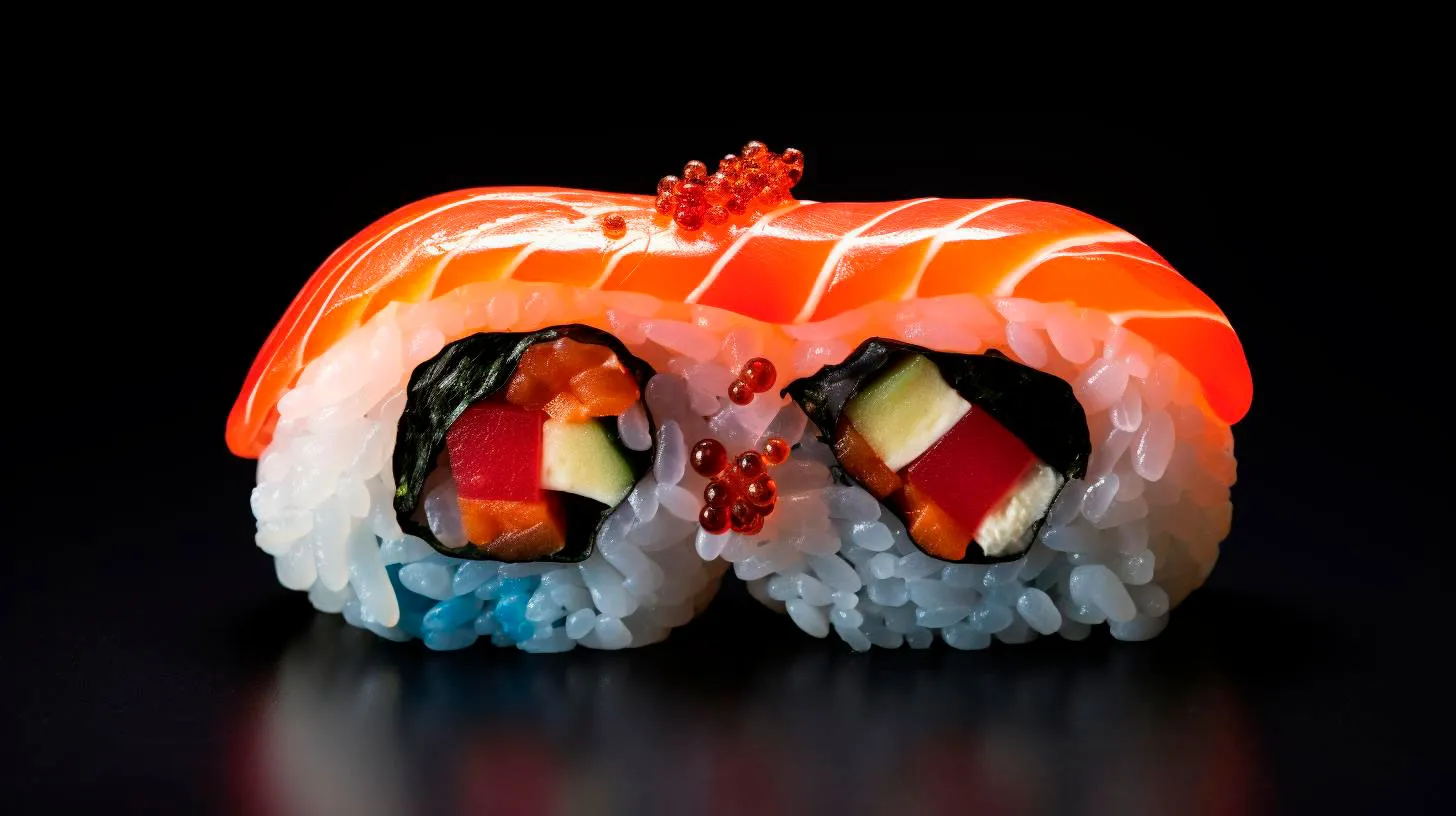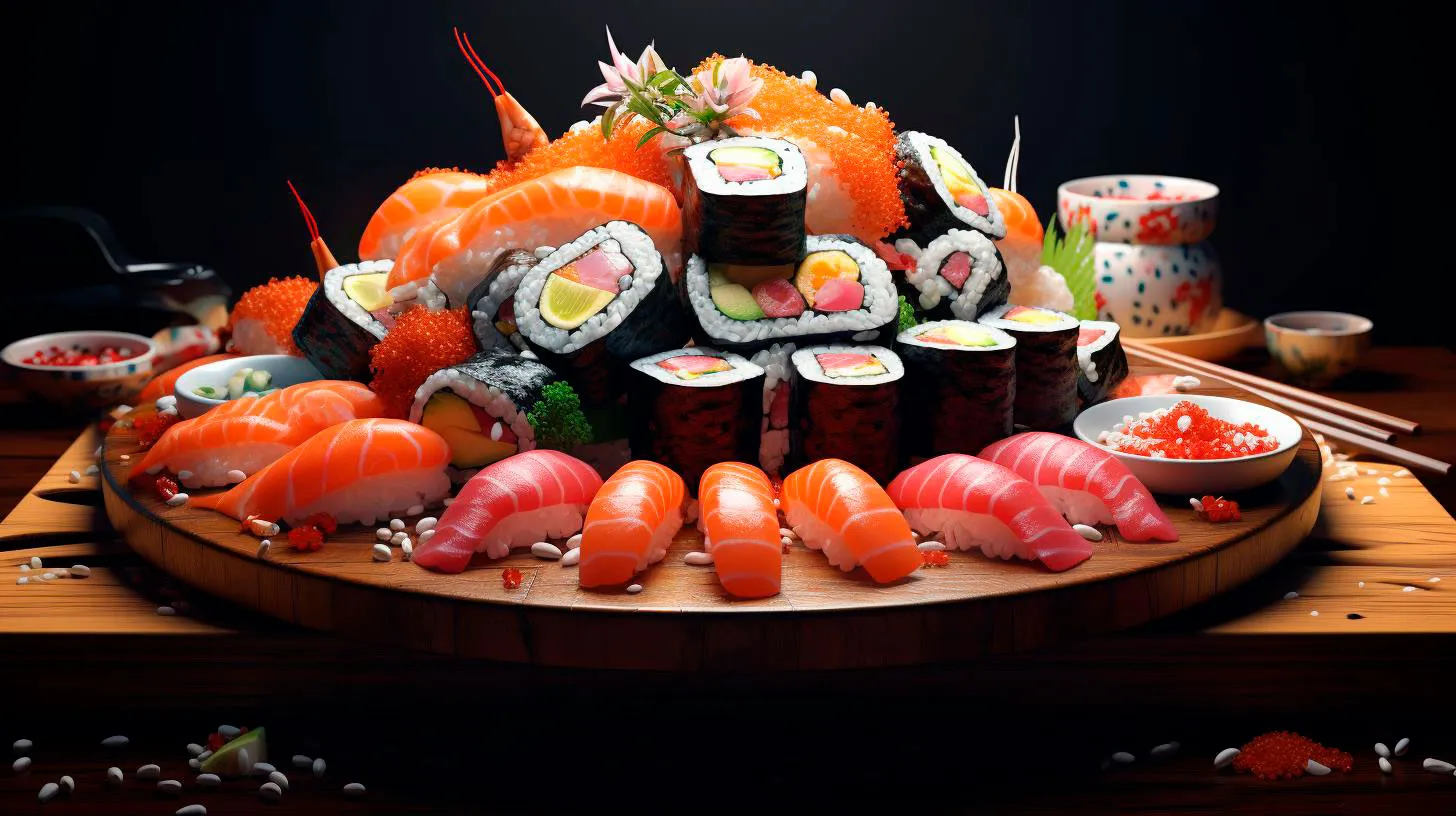Sushi Unleashed: Embark on an Exquisite Flavor Exploration
If you’re a sushi enthusiast or someone looking to dive into the world of this delectable cuisine, get ready for an extraordinary flavor exploration that will leave you craving for more. In this article, we’ll delve into the fascinating world of sushi and uncover its secrets, flavors, and unique characteristics.
The Art of Sushi Making
Sushi is not just a dish; it’s an art form that has been passed down through generations. Skilled sushi chefs spend years honing their craft, perfecting the delicate balance of flavors, textures, and presentation. Every piece of sushi is created with meticulous attention to detail, and the results are truly awe-inspiring. Here are some key takeaways about the art of sushi making:
- Sushi is made using fresh, high-quality ingredients such as fish, vegetables, and rice.
- The chef carefully selects and prepares each ingredient to ensure maximum flavor and texture.
- Traditional sushi is often served with soy sauce, wasabi, and pickled ginger to enhance the flavors.
- The presentation of sushi is just as important as its taste. Chefs create beautiful arrangements that are visually pleasing.
Varieties of Sushi
Sushi comes in a wide range of varieties, each offering a unique taste and experience. From nigiri to maki, each type has its own distinct characteristics. Here are some popular sushi varieties you should try:
1. Nigiri Sushi
Nigiri sushi consists of a slice of raw fish or seafood placed on top of a small mound of vinegared rice. It is usually served with a touch of wasabi between the fish and rice. Key features of nigiri sushi include:
- The simplicity of flavors allows the freshness of the fish to shine through.
- The texture contrast between the soft rice and tender fish creates a perfect harmony.
2. Maki Sushi
Maki sushi, also known as sushi rolls, is made by rolling together rice, fish or vegetables, and seaweed (nori) with the help of a bamboo mat. The rolls are then sliced into bite-sized pieces. Key features of maki sushi include:
- The combination of different ingredients creates a diverse range of flavors and textures.
- Popular maki sushi variations include California roll, spicy tuna roll, and dragon roll.
3. Sashimi
Sashimi is not technically sushi as it does not contain rice. It is a dish consisting of thinly sliced raw fish or seafood served with soy sauce and wasabi. Key features of sashimi include:
- Sashimi highlights the purity and freshness of the fish, allowing you to savor its natural flavors.
- It requires impeccable knife skills to achieve the perfect thickness and texture.
The Advantages of Sushi
Apart from its tantalizing flavors, sushi offers several advantages that make it a healthy and unique dining choice. Here are the key benefits of indulging in sushi:
- Sushi is low in calories and high in nutrients, making it a nutritious option for those watching their diet.
- The omega-3 fatty acids found in fish used in sushi offer numerous health benefits, including reducing the risk of heart disease.
- Sushi is often wrapped in seaweed, known as nori, which is packed with vitamins, minerals, and antioxidants.
- The combination of flavors and textures in sushi stimulates the senses and provides a memorable dining experience.
Revel in the World of Sushi
Now that you have a glimpse into the world of sushi, it’s time to embark on your own exquisite flavor exploration. Whether you’re a sushi connoisseur or a first-timer, indulge in the artistry and flavors that sushi offers. Discover the delicacy of nigiri sushi, the diversity of maki rolls, and the simplicity of sashimi. Sushi has truly unleashed its culinary prowess, captivating hearts and taste buds across the globe.
So, the next time you sit down at a sushi bar, remember to appreciate the craftsmanship and passion that goes into creating each piece. Take your taste buds on an unforgettable journey, and let sushi tantalize your senses like never before.
Taste the World: The Adventurous Palette of Sushi
Types of Sushi
When it comes to sushi, there is a wide range of options to explore. Here are some of the most popular types:
- Nigiri: Nigiri sushi consists of a small mound of rice topped with a slice of raw fish or seafood. It is often served with a dab of wasabi between the rice and fish.
- Maki: Maki sushi is made by rolling rice, fish, and vegetables in a sheet of seaweed called nori. It is then sliced into bite-sized rolls. Maki sushi offers endless possibilities for creative combinations.
- Sashimi: Sashimi is not technically sushi as it doesn’t contain rice. It is thinly sliced raw fish or seafood served on its own. Sashimi allows the pure flavors of the fish to shine.
- Temaki: Temaki sushi, also known as hand rolls, are cone-shaped rolls filled with a variety of ingredients. They are meant to be eaten with your hands for a more interactive dining experience.
Health Benefits of Sushi
Not only a culinary delight, sushi is also packed with health benefits. Here are a few reasons why sushi is a good choice for those looking for a nutritious meal:
- Rich in Omega-3 Fatty Acids: The high fish content in sushi makes it a rich source of omega-3 fatty acids, which are essential for brain health and heart function.
- Low in Calories: Sushi is typically low in calories, especially when compared to other popular fast food options. This makes it a great choice for those watching their weight.
- High in Protein: Sushi is a protein-packed meal, thanks to the fish or seafood used. Protein is essential for muscle growth, tissue repair, and overall health.
- Packed with Antioxidants: Many sushi ingredients, such as seaweed, ginger, and soy sauce, are rich in antioxidants that help boost the immune system and protect against disease.
Cultural Significance of Sushi
Sushi has deep cultural roots in Japan, where it has been enjoyed for centuries. Here are a few key takeaways on the cultural significance of sushi:
- Art of Presentation: Sushi is not only about the taste but also about the visual appeal. Traditional sushi chefs spend years mastering the art of presentation, creating edible works of art.
- Japanese Dining Etiquette: Sushi is deeply rooted in Japanese dining culture, with its own set of rules and etiquette. For example, it is polite to eat sushi with your hands rather than chopsticks.
- Festive Celebrations: Sushi plays a significant role in Japanese celebrations and festivals. It is often served during special occasions and is seen as a symbol of good luck and prosperity.
The Global Influence of Sushi
Sushi’s popularity has transcended borders and is now enjoyed by people from all walks of life. Here are some industry statistics that highlight the global influence of sushi:
- According to Statista, the global sushi market is projected to reach a valuation of $22.56 billion by 2025.
- A survey conducted by the Japan External Trade Organization revealed that the United States consumes the most sushi outside of Japan.
- In recent years, sushi has become a mainstream food choice in many countries, with sushi restaurants popping up in every corner of major cities.
As sushi continues to captivate taste buds worldwide, it’s important to embrace the adventurous nature of this culinary delight. With its diverse types, health benefits, and cultural significance, sushi offers a truly unique dining experience.
So why not step out of your comfort zone and explore the world of sushi? You might discover new flavors, expand your culinary horizons, and develop an appreciation for one of Japan’s greatest culinary exports. Whether you’re a sushi enthusiast or a curious first-timer, there’s a sushi roll waiting to tantalize your taste buds and take you on a gastronomic adventure.
Sushi: A Culinary Journey Through the World of Flavors
In this article, we will explore the history, types, and health benefits of sushi, unraveling the secrets behind this exquisite dish.
A Brief History of Sushi
Sushi has a long and fascinating history that dates back to the 8th century in Japan, where it started as a method of preserving fish. Originating from a simple combination of fermented rice and salted fish, sushi underwent various transformations over the centuries. It wasn’t until the 17th century that sushi, as we know it today, emerged. Hanaya Yohei, a sushi chef in Tokyo, introduced the concept of combining vinegared rice with various ingredients such as seafood, vegetables, and sauces, creating the modern sushi roll.
Sushi gained popularity outside of Japan after World War II, particularly in the United States. American sushi pioneers like Noritoshi Kanai and Ichiro Mashita played significant roles in popularizing sushi and adapting it to Western tastes. Today, sushi has become a global phenomenon, with diverse variations available to suit every palate.
The Types of Sushi
Sushi encompasses a wide range of delicacies, each offering its unique flavors and textures. Here are some popular types of sushi:
1. Nigiri
Nigiri sushi consists of a small hand-pressed mound of vinegared rice topped with fresh seafood. Common toppings include tuna, salmon, shrimp, and eel. Nigiri sushi allows the natural flavors of the fish to shine through.
2. Maki
Maki sushi refers to the famous sushi rolls that most people are familiar with. It consists of sushi rice and ingredients such as fish, vegetables, and sauces wrapped in a sheet of seaweed (nori). Maki rolls come in various styles, including California Roll, Dragon Roll, and Spicy Tuna Roll.
3. Sashimi
Sashimi, although not technically sushi, is a staple in Japanese cuisine. It consists of thin slices of raw fish or seafood served alone, without rice. Freshness and quality are key when it comes to enjoying sashimi.
4. Temaki
Temaki sushi, also known as hand rolls, are cone-shaped rolls filled with sushi rice, fish, and vegetables. The beauty of temaki lies in the ability to customize each roll according to personal preferences.
The Health Benefits of Sushi
Sushi offers not only a delightful culinary experience but also several health benefits. Here are some key advantages:
- Sushi is rich in omega-3 fatty acids, which are known to promote heart health and reduce the risk of cardiovascular diseases.
- The high protein content in sushi makes it a great choice for those looking to build muscle or maintain a healthy diet.
- Seaweed, a common ingredient in sushi, is packed with vitamins, minerals, and antioxidants that boost the immune system and support overall health.
- The fermentation process involved in making sushi rice promotes the growth of beneficial probiotics, which aid digestion and promote a healthy gut.
However, it’s worth noting that sushi should be consumed in moderation due to its sodium content and the potential presence of mercury in certain fish varieties.
Key Takeaways
- Sushi is a culinary art form that goes beyond raw fish and rice.
- It has a rich history dating back to the 8th century in Japan.
- Popular types of sushi include nigiri, maki, sashimi, and temaki.
- Sushi offers various health benefits, such as omega-3 fatty acids and probiotics.
- Enjoy sushi in moderation to maintain a balanced diet.
In conclusion, sushi takes us on a journey of flavors, bringing together tradition, innovation, and health. Whether you are a sushi enthusiast or a newbie, exploring the diverse world of sushi is a delightful experience. So grab those chopsticks and embark on this tantalizing culinary adventure!
Exploring the Delights of Sushi: A Gastronomic Adventure
The Art and Origins of Sushi
Sushi originated in Southeast Asia and was introduced to Japan around the 8th century. Initially, sushi was made by fermenting fish with rice, which was later discarded. Over the centuries, sushi evolved into the form we know today, using fresh, raw fish combined with vinegared rice.
Key Takeaway: Sushi has a rich history dating back centuries and has evolved into a delectable culinary masterpiece enjoyed worldwide.
Types of Sushi
There are various types of sushi, each with its own distinct characteristics. Let’s explore some of the most popular ones:
1. Nigiri Sushi
Nigiri sushi consists of a hand-pressed mound of vinegared rice topped with a slice of fresh fish or seafood. It showcases the chef’s skill in shaping the rice and selecting the perfect ingredients.
2. Maki Sushi
Maki sushi, also known as sushi rolls, is made by wrapping a sheet of seaweed (nori) around rice, fish, and vegetables. It is then sliced into bite-sized pieces. Maki sushi offers a variety of flavors and textures in each roll.
3. Sashimi
Sashimi refers to thin slices of raw fish or seafood that are served without rice. It emphasizes the natural flavors and textures of the fish, allowing you to appreciate its freshness and quality.
4. Temaki
Temaki, or hand rolls, are cone-shaped sushi rolls wrapped in nori and filled with rice, fish, and vegetables. They are often enjoyed as a casual snack or appetizer.
5. Chirashi
Chirashi sushi, also known as scattered sushi, is a bowl of vinegared rice topped with a mixture of sashimi, vegetables, and other garnishes. It offers a colorful and vibrant presentation.
6. Oshizushi
Oshizushi is a pressed sushi dish made by layering rice and toppings in a wooden mold and compressing it firmly. The result is a rectangular block that is later sliced into bite-sized pieces.
Key Takeaway: Sushi can be enjoyed in various forms, each offering a delightful combination of flavors and textures.
Health Benefits of Sushi
In addition to its exquisite taste, sushi also offers several health benefits. Here are some reasons why sushi should be a part of your diet:
- Rich in Omega-3 Fatty Acids: Fish like salmon and tuna are excellent sources of Omega-3 fatty acids, which are essential for heart health and brain function.
- Low in Calories: Sushi is generally low in calories and can be a healthy option for those watching their weight, especially when choosing nigiri or sashimi.
- High in Protein: Sushi provides a good source of lean protein, aiding in muscle growth and repair.
- Packed with Nutrients: Sushi often includes vegetables like avocado and cucumber, adding important vitamins and minerals to your meal.
- Contains Antioxidants: The seaweed used in sushi contains antioxidants that help protect your body against free radicals.
Key Takeaway: Sushi offers a range of health benefits, including Omega-3 fatty acids, low-calorie options, high protein content, and valuable nutrients.
Conclusion
Sushi is not just a meal; it is a gastronomic adventure that takes your taste buds on an unforgettable journey. Understanding the artistry, history, and health benefits of sushi enhances the overall experience. So, the next time you have the opportunity, be sure to explore the delights of sushi and indulge in the flavors that have captivated millions around the world.



